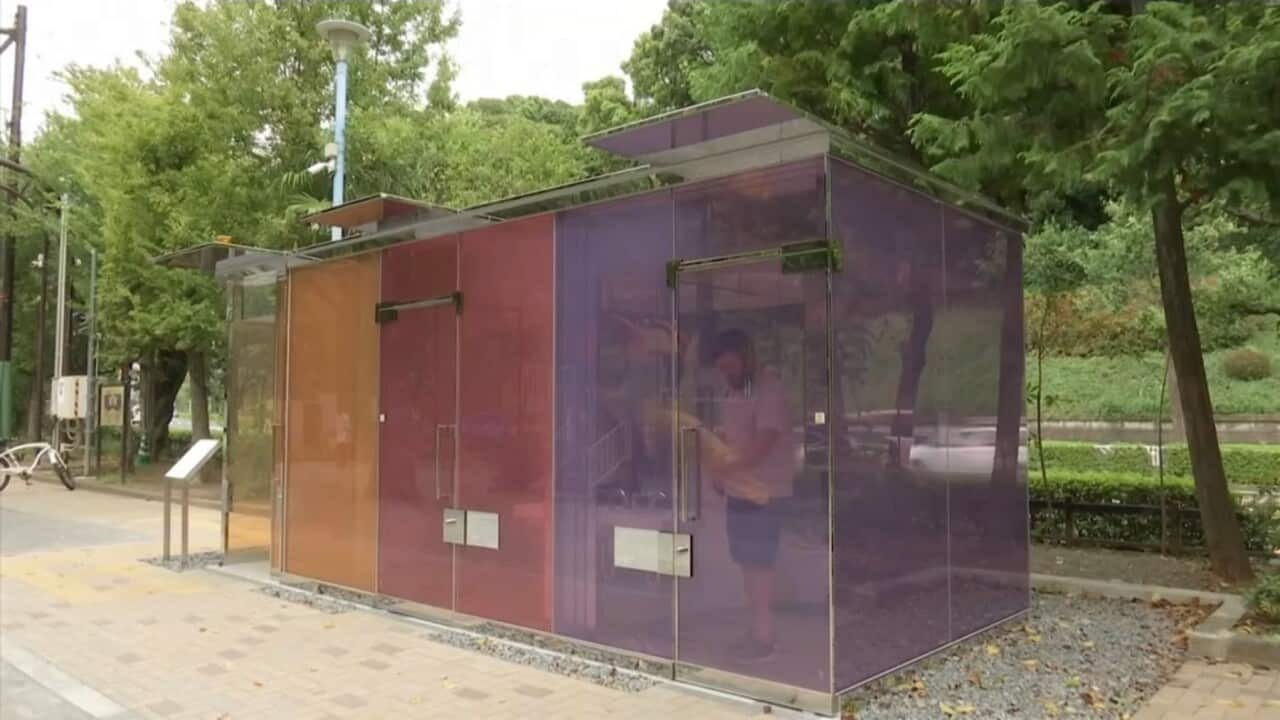Italian
Usereste un bagno pubblico trasparente?
I residenti di un quartiere di Tokyo ora possono, dopo che i nuovi bagni pubblici trasparenti hanno aperto questo mese.
Le pareti esterne dei servizi igienici hanno uno strato di vetro che rimane trasparente quando collegato a una fonte di energia elettrica.
Ma quando la porta è chiusa, la corrente viene interrotta e una speciale pellicola rende il vetro opaco per nascondere l'utente.
Sono stati progettati dal pluripremiato architetto giapponese Shigeru Ban per un progetto organizzato dalla Nippon Foundation, che ha ridisegnato un totale di 17 bagni pubblici a Shibuya.
L'obiettivo: renderli accessibili a chiunque, indipendentemente dal sesso, dall'età o dalla disabilità.
Le pareti trasparenti brillano di colori vivaci: verde, giallo, arancione.
Cecilia Lopez, una travel blogger argentina, li ha provati.
"Maybe I feel a little anxious the first time, like will this work? Is somebody in the glass trying to look inside or something? But I think it's more for the fun of it, to really feel comfortable inside."
Lo ha fatto anche Sebastian Defeo, anche lui argentino, che pensa che i bagni pubblici giapponesi siano generalmente molto puliti.
"It's crazy that people in Japan think that they are dirty, smelly or not really nice, but I love the project, even though they think that they are trying to improve them."
In Giappone, i servizi igienici hanno avuto origine con capanne costruite sui fiumi risalenti al periodo preistorico di Jomon.
La Nippon Foundation sostiene di aver cercato di ricreare l'aspetto e l'atmosfera di questi primi bagni.
Lo ha fatto combinando in modo casuale 15 muri di cemento.
Gli spazi tra le pareti conducono gli utenti in tre diverse aree pensate per uomini, donne e per tutti.
Il design invita gli utenti a interagire con la struttura come se fosse un'attrezzatura da gioco.
Kana Saji, del team di innovazione sociale della Nippon Foundation, afferma che i muri trasparenti dei bagni rassicurano gli utenti sulla loro pulizia e sul fatto che non siano occupati.
"(When designing this) there are two concerns when using Tokyo toilets. First is whether it is clean inside and second if there is anyone hiding inside, so if you can confirm those it will be safe, so that is why it was designed this way. We are using glass, which is a layer of glass and a special film. In the unlocked state, like this, there is an electric current and in a transparent state. When you lock it, the electricity stops, and it becomes opaque."
Le foto dei nuovi bagni sono apparse sui social media, incoraggiando i residenti di Tokyo a venire a provarli.
Tomoko Mizutani è stata fra quelle che hanno fatto il grande passo.
"It's really clean and it sort of looks like art."
English
Would you use a transparent public toilet?
Residents of one Tokyo neighbourhood now can, after new see-through public toilets opened this month.
The outer walls of the toilets have a layer of glass that remains clear when hooked up to an electric current.
But when the door is locked, the current is cut, and a special film makes the glass opaque to conceal the user.
They were designed by award-winning Japanese architect Shigeru Ban for a project organised by The Nippon Foundation that redesigned a total of 17 public toilets in Shibuya.
The goal - to make them accessible to anyone, regardless of gender, age or disability.
The see-through walls glow with vibrant colours - green, yellow, orange.
Cecilia Lopez, a travel blogger from Argentina gave them a go.
"Maybe I feel a little anxious the first time, like will this work? Is somebody in the glass trying to look inside or something? But I think it's more for the fun of it, to really feel comfortable inside."
As did Sebastian Defeo, also from Argentina, who thinks Japanese public toilets generally are very clean.
"It's crazy that people in Japan think that they are dirty, smelly or not really nice, but I love the project, even though they think that they are trying to improve them."
In Japan, toilets originated with huts built over rivers dating back to the prehistoric Jomon period.
The Nippon Foundation says they tried to recreate the appearance and atmosphere of these early toilets.
They did this by randomly combining 15 concrete walls.
The spaces between the walls lead users into three different areas designed for men, women, and everyone.
The design invites users to interact with the facility as if it were a piece of playground equipment.
Kana Saji, from The Nippon Foundation's social innovation team, says the toilets' initial see-through walls reassure users about their cleanliness and whether they're occupied.
"(When designing this) there are two concerns when using Tokyo toilets. First is whether it is clean inside and second if there is anyone hiding inside, so if you can confirm those it will be safe, so that is why it was designed this way. We are using glass, which is a layer of glass and a special film. In the unlocked state, like this, there is an electric current and in a transparent state. When you lock it, the electricity stops, and it becomes opaque."
Photos of the new toilets have been appearing on social media, encouraging Tokyo residents to come and check them out.
Tomoko Mizutani was one of those who took the plunge.
"It's really clean and it sort of looks like art."
Report by Peggy Giakoumelos





